Quantifying the Ecosystem Services of Soda Saline-Alkali Grasslands in Western Jilin Province, NE China
Abstract
:1. Introduction
2. Materials and Methods
2.1. Research Area
2.2. Data Sources
2.3. Research Methods
2.3.1. Research on Grassland Cover Change
2.3.2. Assessment of Grassland Ecosystem Services
2.3.3. Identification of Grassland Ecological Service Hotspots
3. Results
3.1. Analysis of Spatiotemporal Variation in the Characteristics of Grassland in Western Jilin Province
3.1.1. Characteristics of Temporal Change of Grassland Cover
3.1.2. Spatial Variation in Grassland Cover
3.2. Assessment of Grassland Ecosystem Services
3.2.1. Evaluation of Carbon Storage Services
3.2.2. Assessment of Soil Conservation Services
3.2.3. Evaluation of Water Supply Services
3.2.4. Habitat Quality Assessment
3.3. Analysis of Grassland Ecosystem Service Hotspots
3.3.1. Analysis of Ecosystem Service Tradeoffs and Synergies
3.3.2. Identification of Ecosystem Service Hotspots
4. Discussion
4.1. Feasibility of Evaluating Grassland Ecosystem Services Using the InVEST Model
4.2. Analysis of the Distribution of Ecosystem Services across Salinized Grassland in Western Jilin Province
4.3. Practical Applications of the Research Results
4.4. Deviation Analysis and Research Prospects
5. Conclusions
Author Contributions
Funding
Institutional Review Board Statement
Informed Consent Statement
Data Availability Statement
Conflicts of Interest
References
- Manlike, A.; Sawut, R.; Zheng, F.L.; Li, X.S.; Abudukelimu, R. Monitoring and analysing grassland ecosystem service values in response to grassland area changes—An example from northwest China. Rangel. J. 2020, 42, 179–194. [Google Scholar] [CrossRef]
- Wang, Z.; Deng, X.Z.; Song, W.; Li, Z.H.; Chen, J.C. What is the main cause of grassland degradation? A case study of grassland ecosystem service in the middle-south Inner Mongolia. Catena 2017, 150, 100–107. [Google Scholar] [CrossRef]
- Ren, Y.; Lü, Y.; Fu, B. Quantifying the impacts of grassland restoration on biodiversity and ecosystem services in China: A meta-analysis. Ecol. Eng. 2016, 95, 542–550. [Google Scholar] [CrossRef]
- Dong, S.K.; Shang, Z.H.; Gao, J.X.; Boone, R. Enhancing the ecological services of the Qinghai-Tibetan Plateau’s grasslands through sustainable restoration and management in era of global change. Agric. Ecosyst. Environ. 2022, 326, 107756. [Google Scholar] [CrossRef]
- Bardgett, R.D.; Bullock, J.M.; Lavorel, S.; Manning, P.; Schaffner, U.; Ostle, N.; Chomel, M.; Durigan, G.; Fry, E.L.; Johnson, D.; et al. Combatting global grassland degradation. Nat. Rev. Earth Environ. 2021, 2, 720–735. [Google Scholar] [CrossRef]
- Stevens, C.J. Recent advances in understanding grasslands. F1000Research 2018, 7, 1363. [Google Scholar] [CrossRef] [Green Version]
- Mesbahi, G.; Michelot-Antalik, A.; Goulnik, J.; Plantureux, S. Permanent grassland classifications predict agronomic and environmental characteristics well, but not ecological characteristics. Ecol. Indic. 2020, 110, 105956. [Google Scholar] [CrossRef] [Green Version]
- Wu, X.; Li, Z.S.; Fu, B.J.; Zhou, W.M.; Liu, H.F.; Liu, G.H. Restoration of ecosystem carbon and nitrogen storage and microbial biomass after grazing exclusion in semi-arid grasslands of Inner Mongolia. Ecol. Eng. 2014, 73, 395–403. [Google Scholar] [CrossRef]
- Wang, F.; Yuan, X.Z.; Zhou, L.L.; Liu, S.S.; Zhang, M.J.; Zhang, D. Detecting the Complex Relationships and Driving Mechanisms of Key Ecosystem Services in the Central Urban Area Chongqing Municipality, China. Remote Sens. 2021, 13, 4248. [Google Scholar] [CrossRef]
- Zhou, W.; Huang, L.; Yang, H.; Ju, W.M.; Yue, T.X. Interannual variation in grassland net ecosystem productivity and its coupling relation to climatic factors in China. Environ. Geochem. Health 2019, 41, 1583–1597. [Google Scholar] [CrossRef]
- Li, Y.; Li, Q.; Guo, D.; Liang, S.; Wang, Y. Ecological stoichiometry homeostasis of Leymus chinensis in degraded grassland in western Jilin Province, NE China. Ecol. Eng. 2016, 90, 387–391. [Google Scholar] [CrossRef]
- Li, Y.; Liang, S.; Zhao, Y.; Li, W.; Wang, Y. Machine learning for the prediction of L. chinensis carbon, nitrogen and phosphorus contents and understanding of mechanisms underlying grassland degradation. J. Environ. Manag. 2017, 192, 116–123. [Google Scholar] [CrossRef] [PubMed]
- Li, Y.; Gong, H.; Li, S.; Zhang, Y. Ecological Stoichiometry Homeostasis of Six Microelements in Leymus chinensis Growing in Soda Saline-Alkali Soil. Sustainability 2020, 12, 4226. [Google Scholar] [CrossRef]
- Gong, H.; Li, Y.; Li, S. Effects of the interaction between biochar and nutrients on soil organic carbon sequestration in soda saline-alkali grassland: A review. Glob. Ecol. Conserv. 2021, 26, e01449. [Google Scholar] [CrossRef]
- Liu, H.; Li, Y.; Li, S. Cu and Na contents regulate N uptake of Leymus chinensis growing in soda saline-alkali soil. PLoS ONE 2020, 15, e0243172. [Google Scholar] [CrossRef] [PubMed]
- Huang, L.; Cao, W.; Xu, X.L.; Fan, J.W.; Wang, J.B. Linking the benefits of ecosystem services to sustainable spatial planning of ecological conservation strategies. J. Environ. Manag. 2018, 222, 385–395. [Google Scholar] [CrossRef]
- Zheng, X.Y.; Zhang, J.Z.; Cao, S.X. Net value of grassland ecosystem services in mainland China. Land Use Policy 2018, 79, 94–101. [Google Scholar] [CrossRef]
- Chang, J.W. Implications of Xi Jinping’s Thought on Ecological Civilization. Chin. J. Urban Environ. Stud. 2019, 7, 1975005. [Google Scholar] [CrossRef]
- Schroter, M.; Stumpf, K.H.; Loos, J.; van Oudenhoven, A.P.E.; Bohnke-Henrichs, A.; Abson, D.J. Refocusing ecosystem services towards sustainability. Ecosyst. Serv. 2017, 25, 35–43. [Google Scholar] [CrossRef]
- Townsend, M.; Davies, K.; Hanley, N.; Hewitt, J.E.; Lundquist, C.J.; Lohrer, A.M. The Challenge of Implementing the Marine Ecosystem Service Concept. Front. Mar. Sci. 2018, 5, 5. [Google Scholar] [CrossRef] [Green Version]
- Crook, S.E.S.; Levine, A.; Lopez-Carr, D. Perceptions and Application of the Ecosystem Services Approach among Pacific Northwest National Forest Managers. Sustainability 2021, 13, 1259. [Google Scholar] [CrossRef]
- Costanza, R.; d Arge, R.; de Groot, R.; Farber, S.; Grasso, M.; Hannon, B.; Limburg, K.; Naeem, S.; Oneill, R.V.; Paruelo, J.; et al. The value of the world’s ecosystem services and natural capital. Nature 1997, 387, 253–260. [Google Scholar] [CrossRef]
- Petrie, M.D.; Collins, S.L.; Swann, A.M.; Ford, P.L.; Litvak, M.E. Grassland to shrubland state transitions enhance carbon sequestration in the northern Chihuahuan Desert. Glob. Change Biol. 2015, 21, 1226–1235. [Google Scholar] [CrossRef] [PubMed]
- Karimi, A.; Yazdandad, H.; Fagerholm, N. Evaluating social perceptions of ecosystem services, biodiversity, and land management: Trade-offs, synergies and implications for landscape planning and management. Ecosyst. Serv. 2020, 45, 101188. [Google Scholar] [CrossRef]
- Li, Z.H.; Guan, D.J.; Zhou, L.L.; Zhang, Y.J. Constraint relationship of ecosystem services in the Yangtze River Economic Belt, China. Environ. Sci. Pollut. Res. 2022, 29, 12484–12505. [Google Scholar] [CrossRef] [PubMed]
- Tian, P.; Li, J.L.; Cao, L.D.; Pu, R.L.; Gong, H.B.; Zhang, H.T.; Chen, H.L.; Yang, X.D. Assessing Matching Characteristics and Spatial Differences between Supply and Demand of Ecosystem Services: A Case Study in Hangzhou, China. Land 2021, 10, 582. [Google Scholar] [CrossRef]
- Rodriguez, J.P.; Beard, T.D.; Bennett, E.M.; Cumming, G.S.; Cork, S.J.; Agard, J.; Dobson, A.P.; Peterson, G.D. Trade-offs across space, time, and ecosystem services. Ecol. Soc. 2006, 11, 28. [Google Scholar] [CrossRef] [Green Version]
- Agudelo, C.A.R.; Bustos, S.L.H.; Moreno, C.A.P. Modeling interactions among multiple ecosystem services. A critical review. Ecol. Model. 2020, 429, 109103. [Google Scholar] [CrossRef]
- Roces-Diaz, J.V.; Vayreda, J.; Banque-Casanovas, M.; Diaz-Varela, E.; Bonet, J.A.; Brotons, L.; de-Miguel, S.; Herrando, S.; Martinez-Vilalta, J. The spatial level of analysis affects the patterns of forest ecosystem services supply and their relationships. Sci. Total Environ. 2018, 626, 1270–1283. [Google Scholar] [CrossRef] [Green Version]
- Zuo, L.Y.; Gao, J.B. Investigating the compounding effects of environmental factors on ecosystem services relationships for Ecological Conservation Red Line areas. Land Degrad. Dev. 2021, 32, 4609–4623. [Google Scholar] [CrossRef]
- Li, X.B.; Lyu, X.; Dou, H.S.; Dang, D.L.; Li, S.K.; Li, X.; Li, M.Y.; Xuan, X.J. Strengthening grazing pressure management to improve grassland ecosystem services. Glob. Ecol. Conserv. 2021, 31, e01782. [Google Scholar] [CrossRef]
- Liu, L.L.; Zhang, H.B.; Gao, Y.; Zhu, W.J.; Liu, X.; Xu, Q.D. Hotspot identification and interaction analyses of the provisioning of multiple ecosystem services: Case study of Shaanxi Province, China. Ecol. Indic. 2019, 107, 105566. [Google Scholar] [CrossRef]
- Ba, L.; Wang, D.L.; Gao, Y. Analysisof spatial distribution pattern for Leymus chinensis and its co-existing specie—Phragmites communisin the Songnen Plains. Acta Prataculturae Sin. 2005, 14, 111–116. [Google Scholar]
- Liu, S.Y.; Hu, N.K.; Zhang, J.; Lv, Z.C. Spatiotemporal change of carbon storage in the Loess Plateau of northern Shaanxi, based on the InVEST Model. Sci. Cold Arid. Reg. 2018, 10, 240–250. [Google Scholar]
- Lahiji, R.N.; Dinan, N.M.; Liaghati, H.; Ghaffarzadeh, H.; Vafaeinejad, A. Scenario-based estimation of catchment carbon storage: Linking multi-objective land allocation with InVEST model in a mixed agriculture-forest landscape. Front. Earth Sci. 2020, 14, 637–646. [Google Scholar] [CrossRef]
- Tallis, H.; Polasky, S. Mapping and valuing ecosystem services as an approach for conservation and natural-resource management. Ann. N. Y. Acad. Sci. 2009, 1162, 265–283. [Google Scholar] [CrossRef]
- Scordo, F.; Lavender, T.M.; Seitz, C.; Perillo, V.L.; Rusak, J.A.; Piccolo, M.C.; Perillo, G.M.E. Modeling Water Yield: Assessing the Role of Site and Region-Specific Attributes in Determining Model Performance of the InVEST Seasonal Water Yield Model. Water 2018, 10, 1496. [Google Scholar] [CrossRef] [Green Version]
- Canqiang, Z.; Wenhua, L.; Biao, Z.; Moucheng, L. Water yield of Xitiaoxi River Basin based on INVEST modeling. J. Resour. Ecol. 2012, 3, 50–54. [Google Scholar] [CrossRef]
- Sharp, R.; Tallis, H.T.; Ricketts, T.; Guerry, A.D.; Ennaanay, D.; Wolny, S.; Olwero, N.; Vigerstol, K.; Pennington, D.; Mendoza, G. InVEST 3.0 User’s Guide: The Natural Capital Project; Stanford University: Stanford, CA, USA, 2016. [Google Scholar]
- Yang, D.; Liu, W.; Tang, L.Y.; Chen, L.; Li, X.Z.; Xu, X.L. Estimation of water provision service for monsoon catchments of South China: Applicability of the InVEST model. Landsc. Urban Plan. 2019, 182, 133–143. [Google Scholar] [CrossRef]
- Mdk, L.; Matlock, M.D.; Cummings, E.C.; Nalley, L.L. Quantifying and mapping multiple ecosystem services change in West Africa. Agric. Ecosyst. Environ. 2013, 165, 6–18. [Google Scholar]
- Su, C.; Fu, B. Evolution of ecosystem services in the Chinese Loess Plateau under climatic and land use changes. Glob. Planet. Change 2013, 101, 119–128. [Google Scholar] [CrossRef]
- Hussain, A.M.T.; Tschirhart, J. Economic/ecological tradeoffs among ecosystem services and biodiversity conservation. Ecol. Econ. 2013, 93, 116–127. [Google Scholar] [CrossRef]
- Jia, X.Q.; Fu, B.J.; Feng, X.M.; Hou, G.H.; Liu, Y.; Wang, X.F. The tradeoff and synergy between ecosystem services in the grain-for-green areas in northern Shaanxi. Ecol. Indic. 2014, 43, 103–113. [Google Scholar] [CrossRef]
- Yu, B.; Di, X.; Zang, S. New estimating vegetation and soil carbon/nitrogen storage in Daqing region, Heilongjiang. Chin. J. Soil Sci. 2011, 42, 290–297. [Google Scholar]
- Matott, L.S.; Babendreier, J.E.; Purucker, S.T. Evaluating uncertainty in integrated environmental models: A review of concepts and tools. Water Resour. 2009, 45, 45. [Google Scholar] [CrossRef] [Green Version]
- Vormoor, K.; Heistermann, M.; Bronstert, A.; Lawrence, D. Hydrological model parameter (in) stability—“Crash testing” the HBV model under contrasting flood seasonality conditions. Hydrol. Sci. J. 2018, 63, 991–1007. [Google Scholar] [CrossRef]
- Li, M.Y.; Zhou, Y.; Xiao, P.N.; Tian, Y.; Huang, H.; Xiao, L. Evolution of Habitat Quality and Its Topographic Gradient Effect in Northwest Hubei Province from 2000 to 2020 Based on the InVEST Model. Land 2021, 10, 857. [Google Scholar] [CrossRef]
- Chu, L.; Sun, T.C.; Wang, T.W.; Li, Z.X.; Cai, C.F. Evolution and Prediction of Landscape Pattern and Habitat Quality Based on CA-Markov and InVEST Model in Hubei Section of Three Gorges Reservoir Area (TGRA). Sustainability 2018, 10, 3854. [Google Scholar] [CrossRef] [Green Version]
- Vigerstol, K.L.; Aukema, J.E. A comparison of tools for modeling freshwater ecosystem services. J. Environ. Manag. 2011, 92, 2403–2409. [Google Scholar] [CrossRef]
- Ochoa, V.; Urbina-Cardona, N. Tools for spatially modeling ecosystem services: Publication trends, conceptual reflections and future challenges. Ecosyst. Serv. 2017, 26, 155–169. [Google Scholar] [CrossRef]
- Zhang, C.; Xie, G.; Yang, Q.; Li, S. Influence of human activities on the value of ecosystem services: Case study of Zhifanggou watershed. Resour. Sci. 2008, 30, 1910–1915. [Google Scholar]
- Martínez, M.L.; Pérez-Maqueo, O.; Vázquez, G.; Castillo-Campos, G.; García-Franco, J.; Mehltreter, K.; Equihua, M.; Landgrave, R. Effects of land use change on biodiversity and ecosystem services in tropical montane cloud forests of Mexico. For. Ecol. Manag. 2009, 258, 1856–1863. [Google Scholar] [CrossRef]
- Li, F.; Zhang, S.W.; Yang, J.C.; Bu, K.; Wang, Q.; Tang, J.M.; Chang, L.P. The effects of population density changes on ecosystem services value: A case study in Western Jilin, China. Ecol. Indic. 2016, 61, 328–337. [Google Scholar]

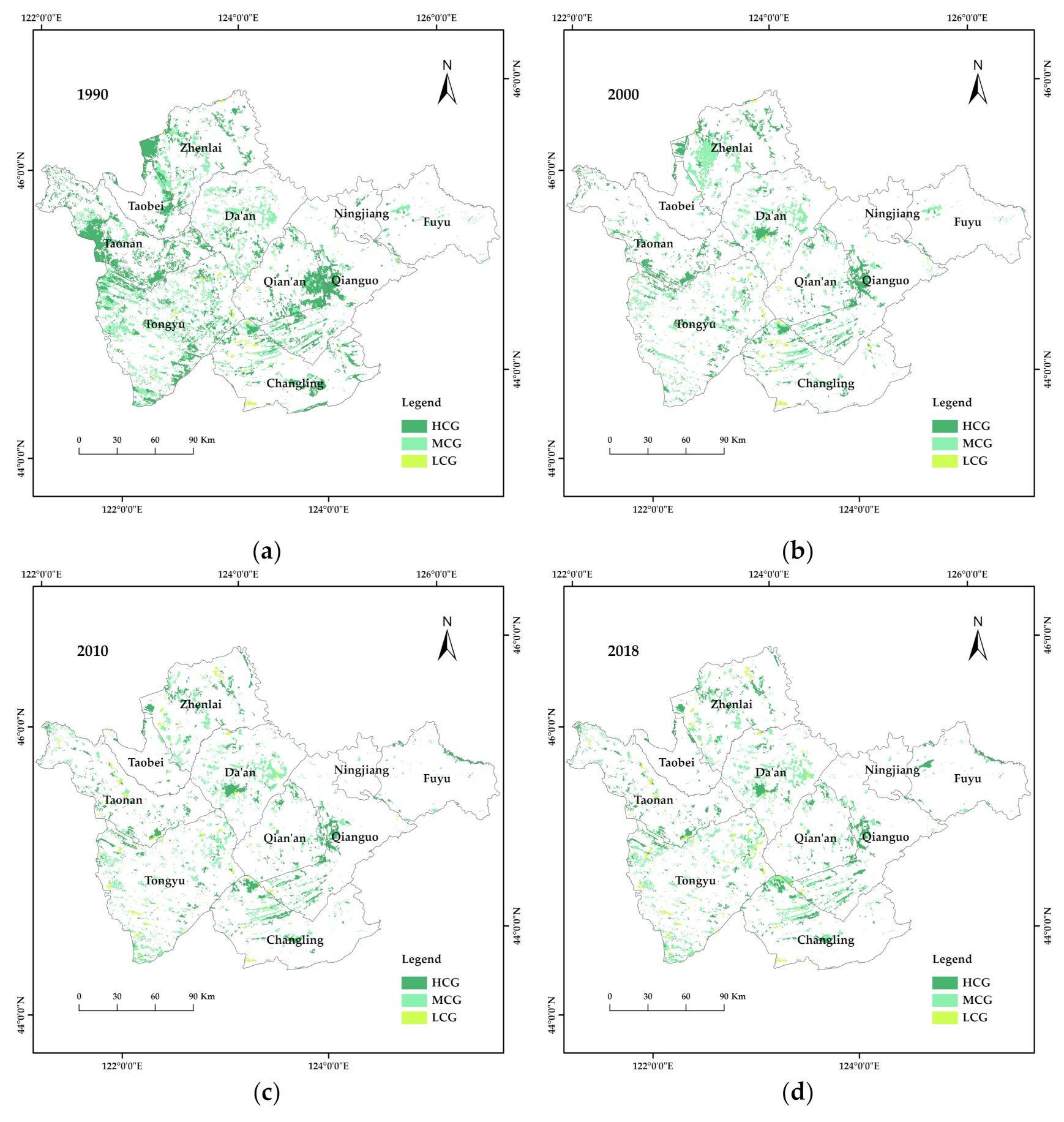
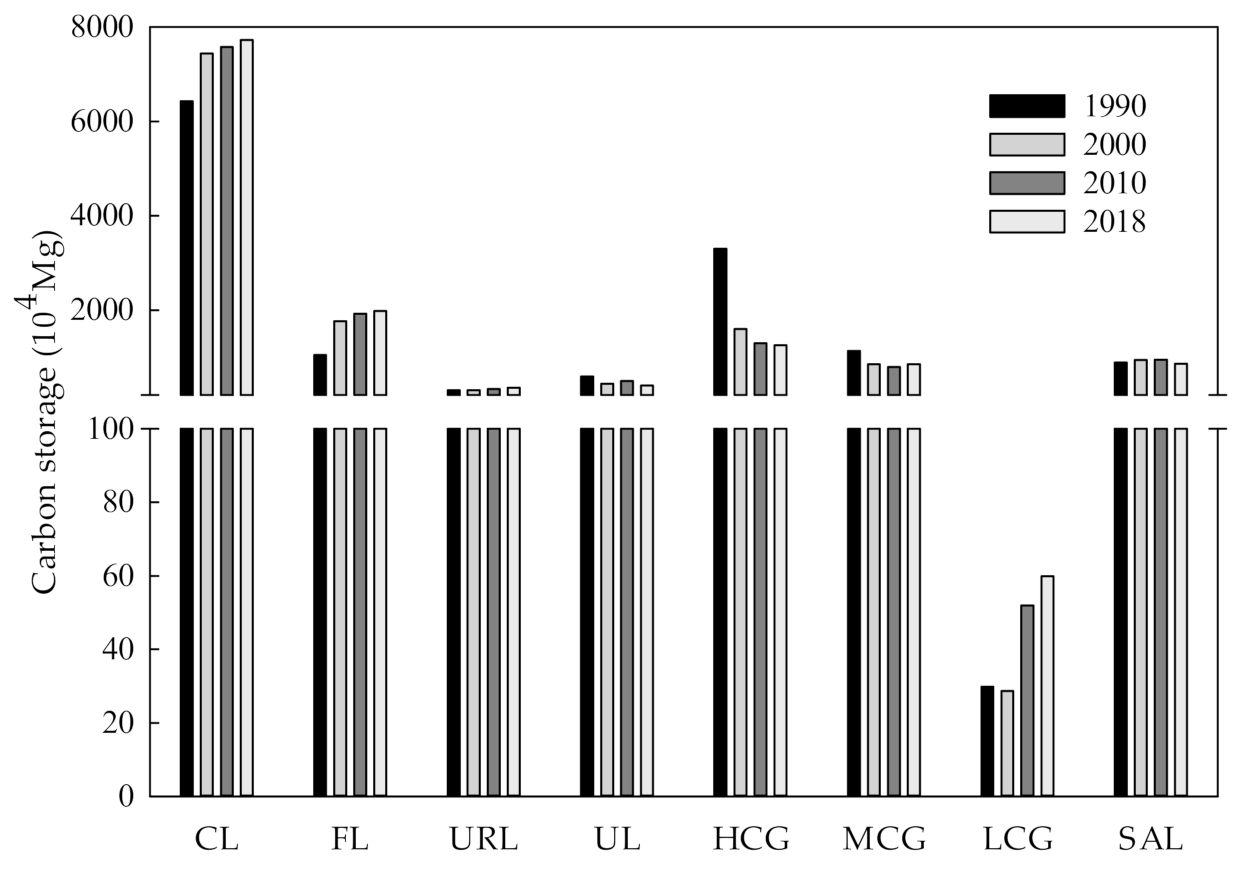
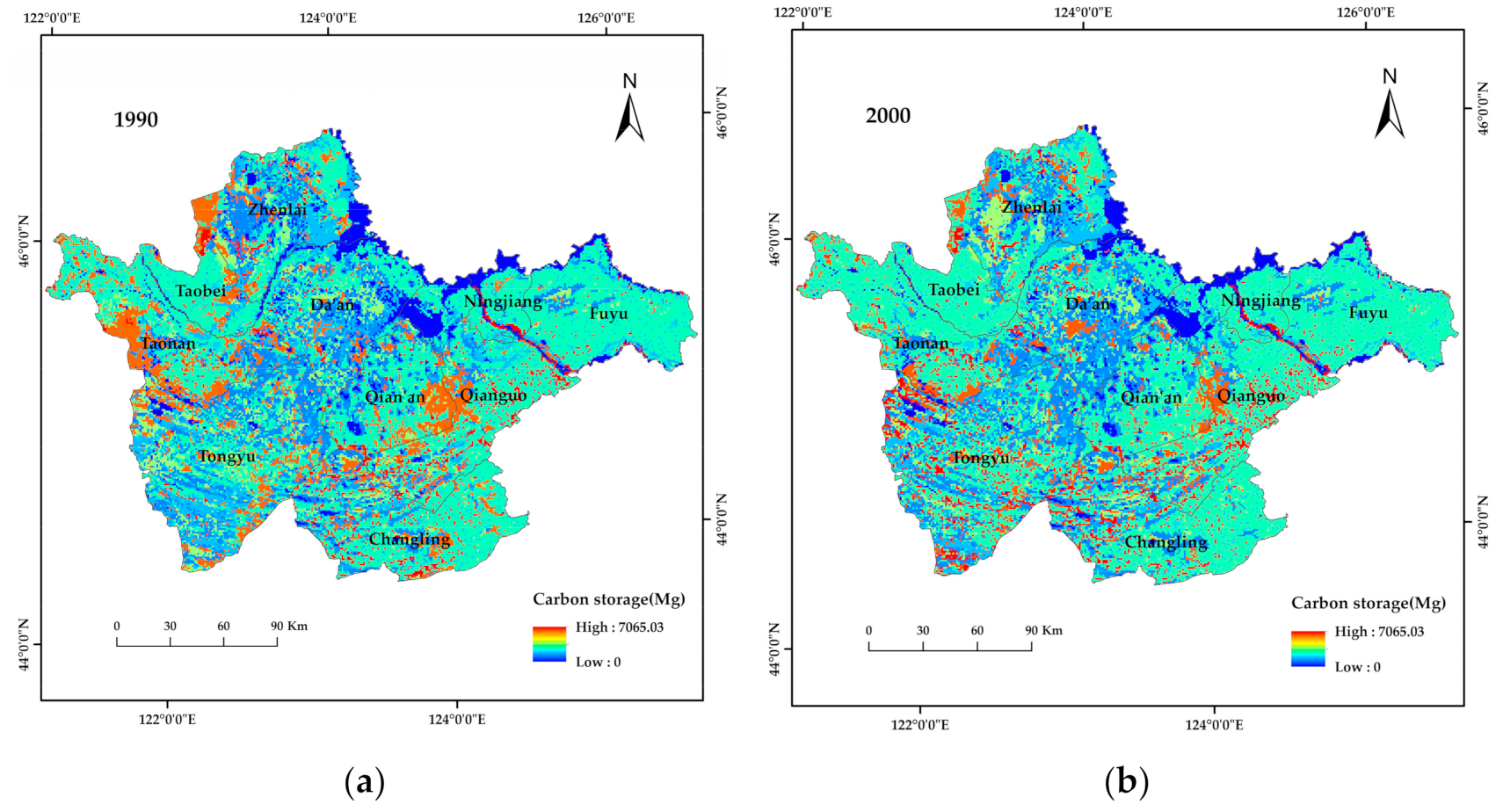
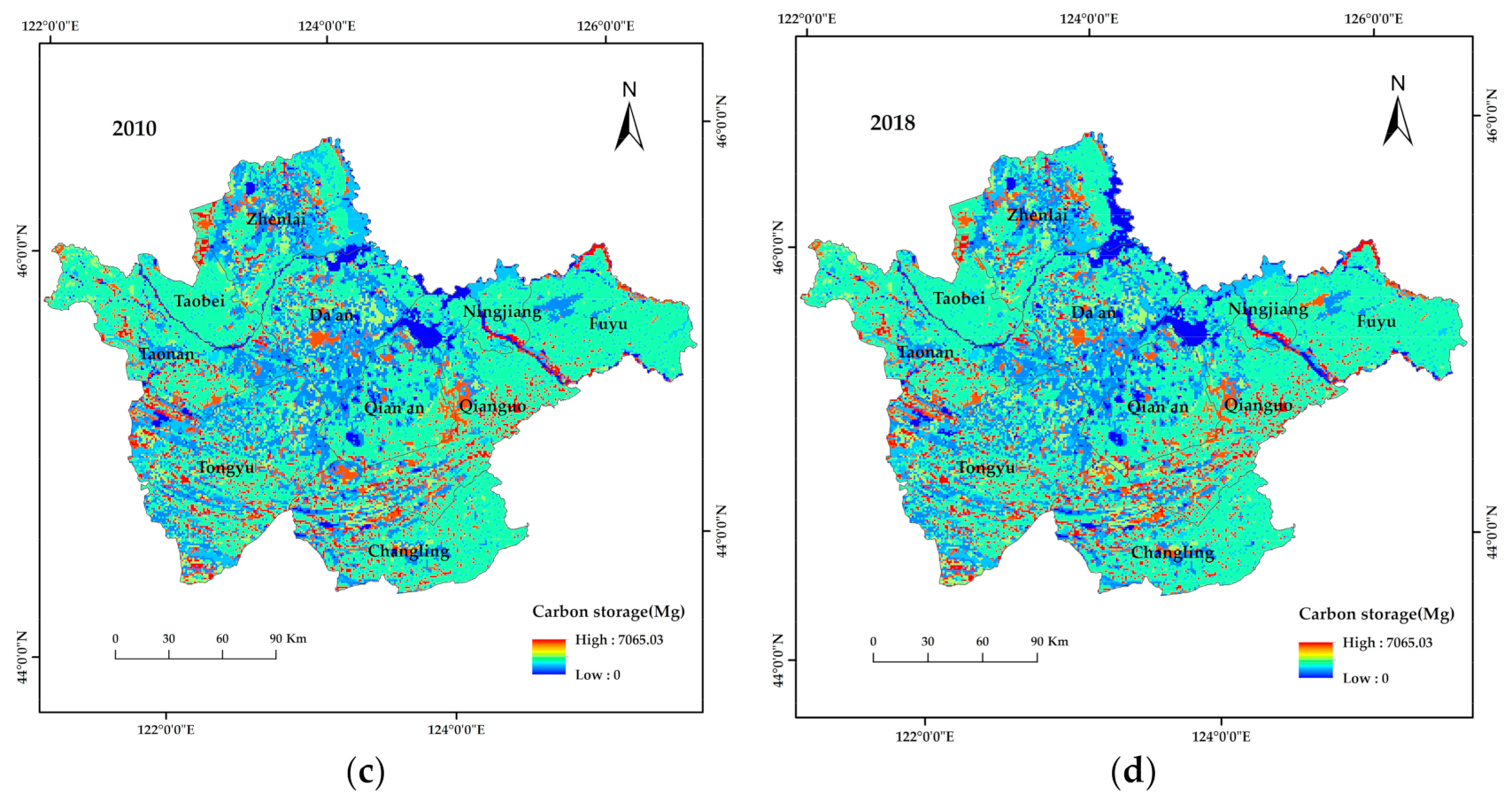
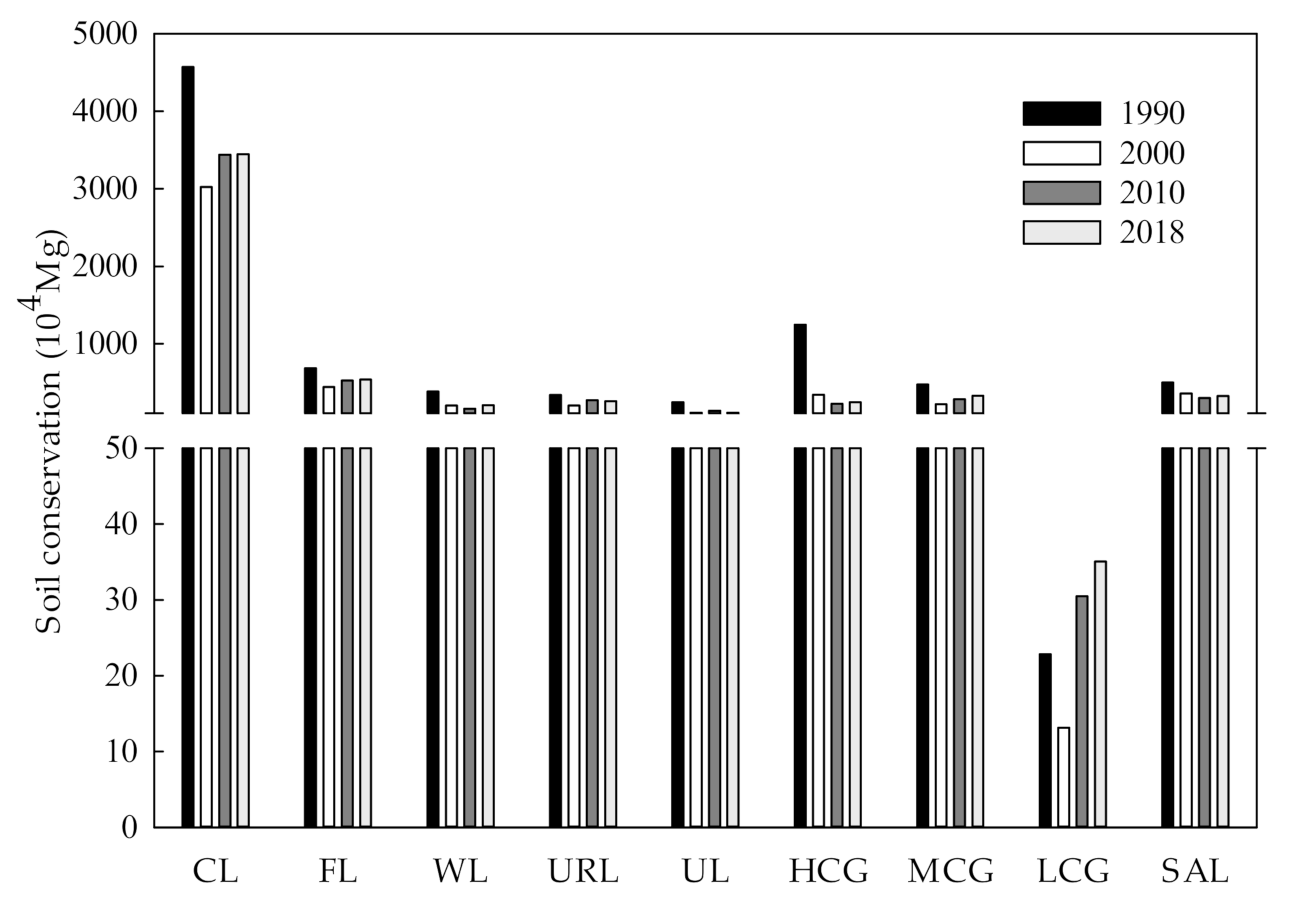
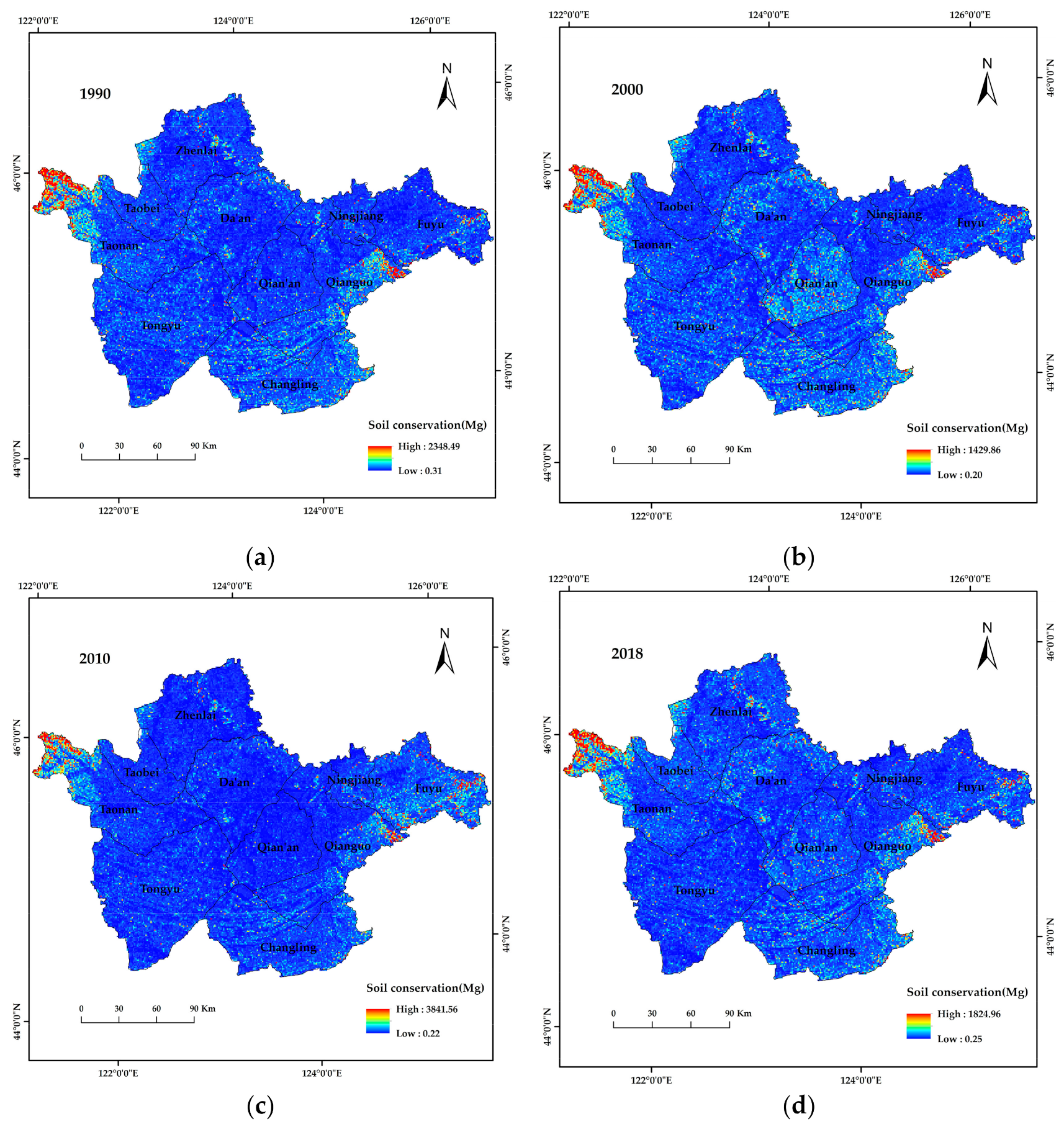
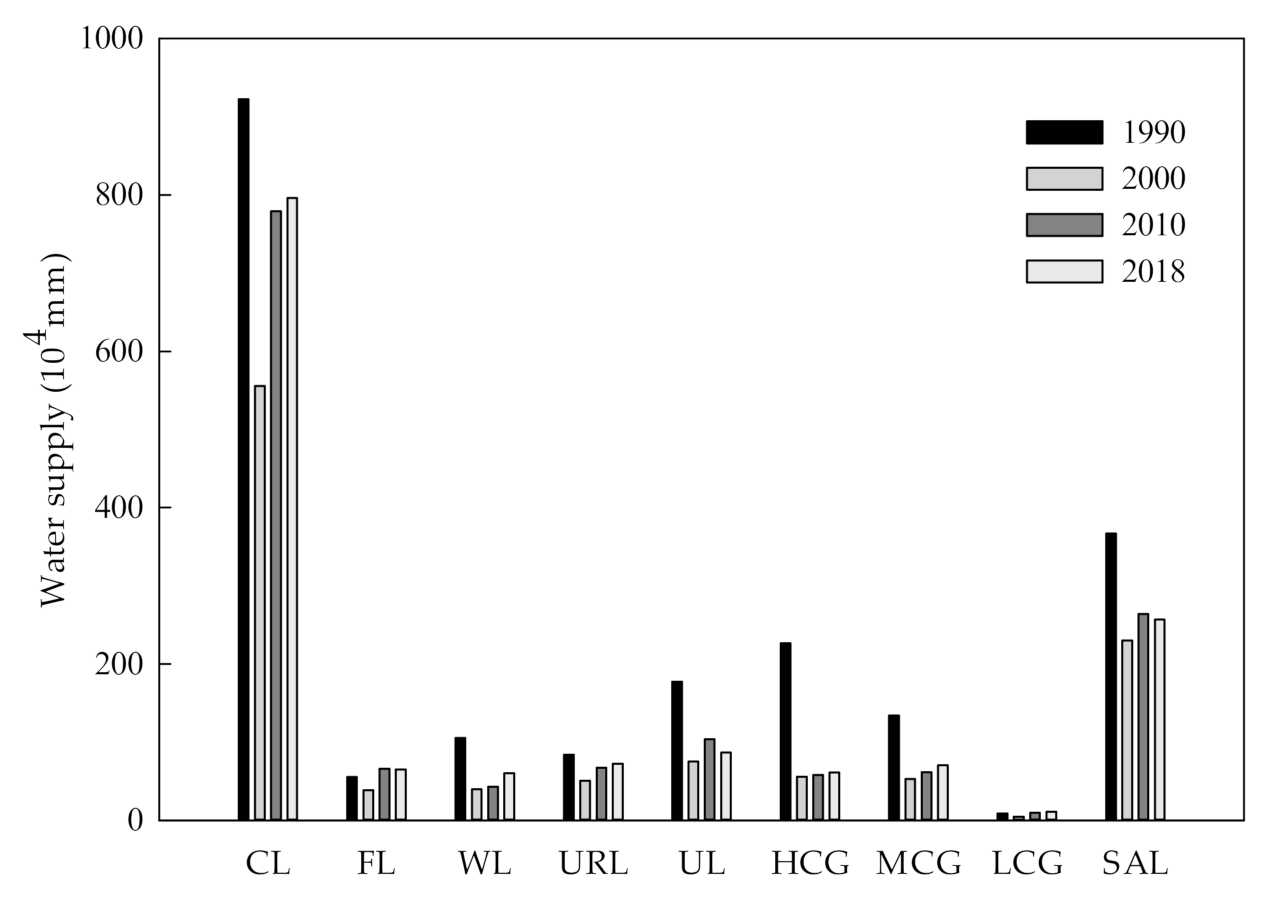
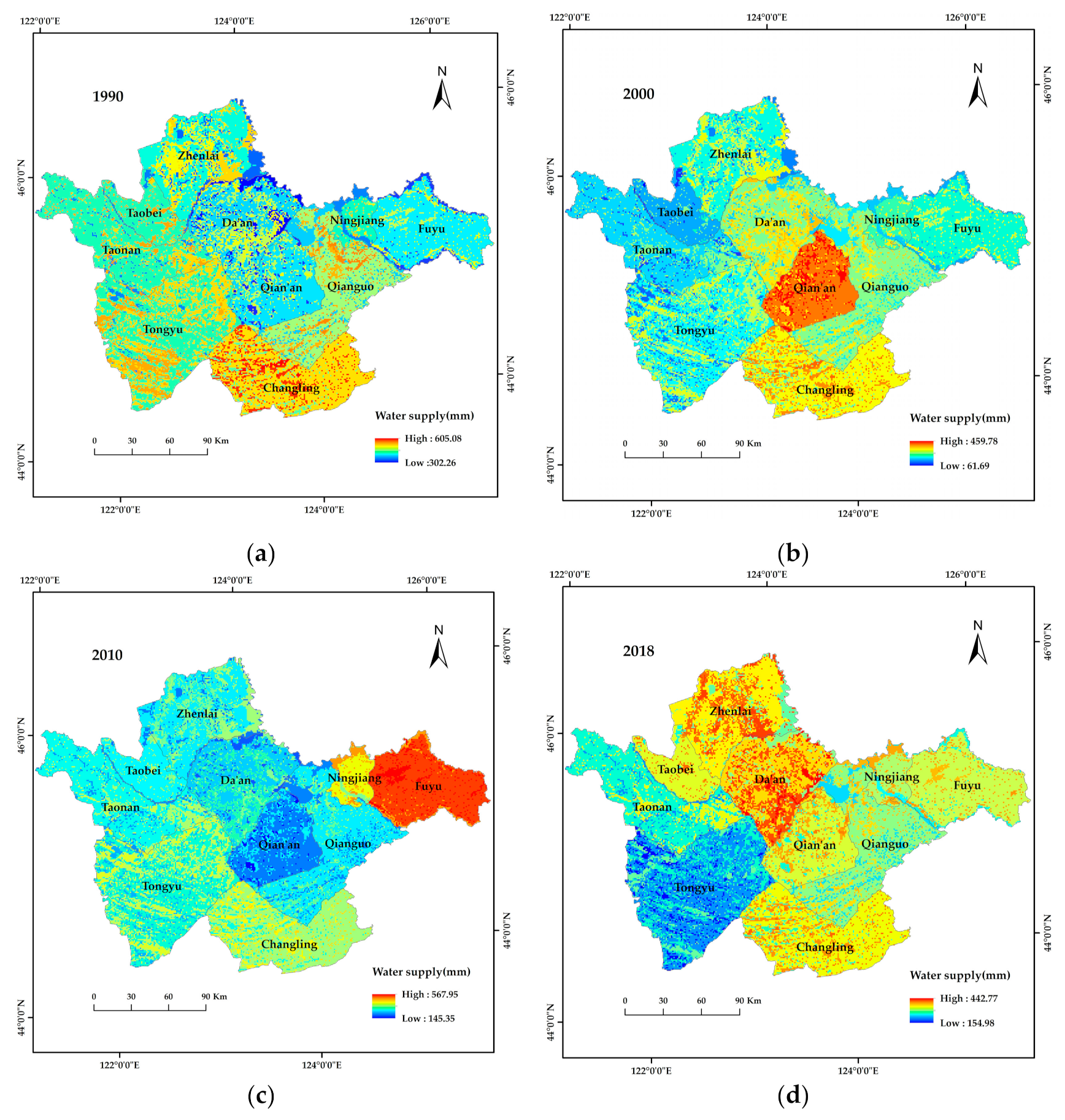
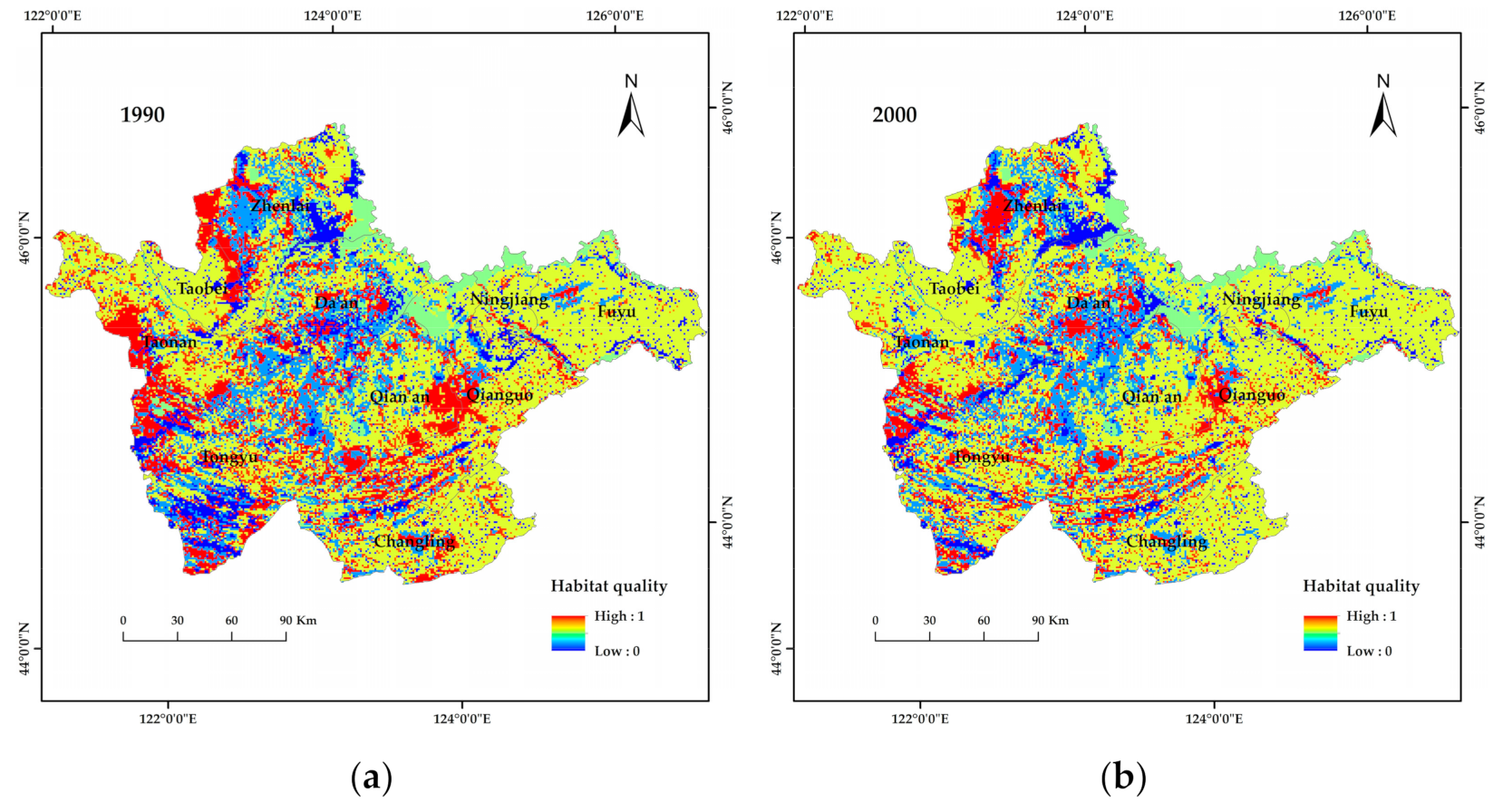



| Time Period | Contribution Rate | CL 1 | FL 2 | WL 3 | URL 4 | UL 5 | HCG 6 | MCG 7 | LCG 8 | SAL 9 |
|---|---|---|---|---|---|---|---|---|---|---|
| 1990–2000 | Conversion-in | 51.56 | 15.65 | 1.64 | 0.35 | 7.16 | 3.27 | 6.68 | 0.28 | 13.41 |
| Conversion-out | 10.69 | 3.75 | 7.86 | 0.00 | 17.61 | 36.25 | 15.92 | 0.33 | 7.58 | |
| 2000–2010 | Conversion-in | 29.46 | 9.36 | 4.50 | 5.07 | 14.65 | 8.29 | 11.16 | 3.30 | 14.21 |
| Conversion-out | 22.12 | 6.94 | 13.39 | 3.39 | 10.12 | 14.77 | 14.19 | 1.42 | 13.64 | |
| 2010–2018 | Conversion-in | 35.36 | 11.80 | 18.01 | 5.82 | 7.30 | 5.03 | 12.12 | 2.00 | 2.58 |
| Conversion-out | 17.58 | 8.74 | 6.13 | 0.55 | 26.91 | 7.44 | 5.92 | 0.25 | 26.48 | |
| 1990–2018 | Conversion-in | 44.61 | 12.74 | 3.66 | 3.84 | 7.64 | 5.00 | 8.05 | 2.20 | 12.26 |
| Conversion-out | 13.30 | 3.89 | 9.65 | 1.71 | 15.25 | 28.20 | 13.83 | 0.89 | 13.29 |
| Land Type | 1990 | 2000 | 2010 | 2018 | Average |
|---|---|---|---|---|---|
| CL 1 | 0.5998 | 0.5999 | 0.5999 | 0.5999 | 0.5999 |
| FL 2 | 0.9782 | 0.9796 | 0.9785 | 0.9776 | 0.9785 |
| WL 3 | 0.4894 | 0.4882 | 0.4844 | 0.4850 | 0.4867 |
| URL 4 | 0 | 0 | 0 | 0 | 0 |
| UL 5 | 0 | 0 | 0 | 0 | 0 |
| HCG 6 | 0.9850 | 0.9806 | 0.9804 | 0.9793 | 0.9814 |
| MCG 7 | 0.9845 | 0.9840 | 0.9816 | 0.9817 | 0.9830 |
| LCG 8 | 0.9881 | 0.9855 | 0.9828 | 0.9842 | 0.9851 |
| SAL 9 | 0.1997 | 0.1996 | 0.1996 | 0.1996 | 0.1996 |
| Average | 0.5805 | 0.5797 | 0.5786 | 0.5786 | -- |
| 1990 | Carbon Storage | Soil Conservation | Water Supply | Habitat Quality |
|---|---|---|---|---|
| Carbon storage | 1.000 | 0.276 ** | −0.454 ** | 0.811 ** |
| Soil conservation | 1.000 | −0.242 ** | 0.221 ** | |
| Water supply | 1.000 | −0.498 ** | ||
| Habitat quality | 1.000 | |||
| 2000 | Carbon storage | Soil conservation | Water supply | Habitat quality |
| Carbon storage | 1.000 | 0.311 ** | −0.414 ** | 0.811 ** |
| Soil conservation | 1.000 | −0.197 ** | 0.236 ** | |
| Water supply | 1.000 | −0.403 ** | ||
| Habitat quality | 1.000 | |||
| 2010 | Carbon storage | Soil conservation | Water supply | Habitat quality |
| Carbon storage | 1.000 | 0.330 ** | −0.468 ** | 0.790 ** |
| Soil conservation | 1.000 | −0.136 ** | 0.241 ** | |
| Water supply | 1.000 | −0.502 ** | ||
| Habitat quality | 1.000 | |||
| 2018 | Carbon storage | Soil conservation | Water supply | Habitat quality |
| Carbon storage | 1.000 | 0.316 ** | −0.182 ** | 0.779 ** |
| Soil conservation | 1.000 | −0.060 ** | 0.232 ** | |
| Water supply | 1.000 | −0.205 ** | ||
| Habitat quality | 1.000 |
| Land Type | 1990 | Proportion | 2000 | Proportion | 2010 | Proportion | 2018 | Proportion |
|---|---|---|---|---|---|---|---|---|
| HCG | H-C | 33.54% | H-C | 23.69% | H-C | 29.93% | H-C | 14.74% |
| H-W-C | 9.51% | H-W-C | 13.32% | H-W-C | 5.67% | H-W-C | 16.79% | |
| H-C-S | 15.07% | H-C-S | 8.87% | H-C-S | 6.72% | H-C-S | 4.84% | |
| 4 types | 3.03% | 4 types | 3.94% | 4 types | 2.30% | 4 types | 5.51% | |
| MCG | H-C | 23.93% | H-C | 28.45% | H-C | 34.85% | H-C | 18.73% |
| H-W-C | 4.84% | H-W-C | 8.54% | H-W-C | 4.59% | H-W-C | 20.90% | |
| H-C-S | 5.81% | H-C-S | 5.63% | H-C-S | 6.57% | H-C-S | 4.98% | |
| 4 types | 1.98% | 4 types | 3.88% | 4 types | 1.98% | 4 types | 5.22% | |
| LCG | H | 1.04% | H | 1.50% | H | 5.39% | H | 4.33% |
| H-W | 0.99% | H-W | 1.77% | H-W | 0.91% | H-W | 2.87% | |
| H-S | 1.04% | H-S | 0.82% |
Publisher’s Note: MDPI stays neutral with regard to jurisdictional claims in published maps and institutional affiliations. |
© 2022 by the authors. Licensee MDPI, Basel, Switzerland. This article is an open access article distributed under the terms and conditions of the Creative Commons Attribution (CC BY) license (https://creativecommons.org/licenses/by/4.0/).
Share and Cite
Chang, L.; Zhao, Z.; Jiang, L.; Li, Y. Quantifying the Ecosystem Services of Soda Saline-Alkali Grasslands in Western Jilin Province, NE China. Int. J. Environ. Res. Public Health 2022, 19, 4760. https://doi.org/10.3390/ijerph19084760
Chang L, Zhao Z, Jiang L, Li Y. Quantifying the Ecosystem Services of Soda Saline-Alkali Grasslands in Western Jilin Province, NE China. International Journal of Environmental Research and Public Health. 2022; 19(8):4760. https://doi.org/10.3390/ijerph19084760
Chicago/Turabian StyleChang, Lei, Zhibo Zhao, Lixin Jiang, and Yuefen Li. 2022. "Quantifying the Ecosystem Services of Soda Saline-Alkali Grasslands in Western Jilin Province, NE China" International Journal of Environmental Research and Public Health 19, no. 8: 4760. https://doi.org/10.3390/ijerph19084760
APA StyleChang, L., Zhao, Z., Jiang, L., & Li, Y. (2022). Quantifying the Ecosystem Services of Soda Saline-Alkali Grasslands in Western Jilin Province, NE China. International Journal of Environmental Research and Public Health, 19(8), 4760. https://doi.org/10.3390/ijerph19084760






